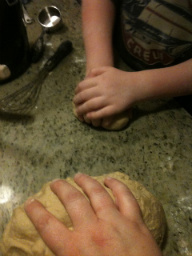
Pain de Campagne variation

Pain de Campagne variation, crumb
A couple of weeks ago, I baked a pain de campagne. The formula evolved from that for baguettes which Anis Bouabsa had shared with Janedo. It had some sourdough starter and some rye flour added to Bouabsa's original. Of course, I didn't have any French T65 flour, so I used KAF "French-style Flour," which is their T55 clone. Also, rather than forming the dough into baguettes, I made one large bâtard. The mixing method was also changed somewhat. After a 20 minute autolyse of the flours and water, the other ingredients are added. The dough is mixed using a method I learned from Hamelman via proth5, although I have since found a very similar method in Reinhart's BBA (see his formula for Pugliese.) The dough is stretched and folded in the mixing bowl with a plastic scraper for 20 strokes, repeating this 3 times over an hour. (20 strokes. 20 minutes rest. 20 more strokes. 20 mintutes rest. 20 strokes.
The critical method I retained from the original was how the dough was fermented: After the autolyse and "kneading," the dough is refrigerated for 21 hours before dividing, shaping and baking.
See my TFL blog entry of August 31, 2008 for more details. (http://www.thefreshloaf.com/node/8454/pain-de-campagne)
King Arthur Flour sells a "specialty flour" they call "European-style Artisan Flour." They have told me this is their approximation of French T65 flour, which is what Ansi Bouabsa actually uses for his baguettes. The European-Style Artisan Flour is a blend of Spring and Winter wheats with some ascorbic acid and some white whole wheat. It is 11.7% protein.
This week, I made pain de campagne again. The only changes from my bake of two weeks ago were 1) I substituted KAF European-style Artisan Flour for KAF French-style Flour, and 2) I made two boules rather than one bâtard.
The European-style flour absorbed more water, resulting in a drier dough. It was also slightly less extensible, but still more so than, say, KAF Bread Flour.
I baked using the same method as before. For the two boules of about 480 gms each, I preheated the oven to 500F and turned it down to 460F after loading the boules and pouring the hot water in the skillet. The water was removed after 10 minutes. After another 10 minutes, the loaves were "done," but I wanted a darker crust, so baked them for an additional 5 minutes, then left them in the turned-off oven for another 5 minutes.
The crust did not stay as crunchy as the previous version. The crumb was about what I expected. The dough acted like a 68% hydration dough, and the crumb looked like it. The aroma of the sliced bread, 3 hours after baking, had a pronounced smell of wheat bran, and the taste of the whole wheat in the flour really came through. It was only slightly sour. The texture of the crumb was quite nice. It was tender and chewy. My experience suggests the flavors will meld by tomorrow morning, and the taste will change. I'm looking forward to tasting it.
Personally, I prefer the previous iteration, at this time but others may differ. Certainly, both are very nice.
David











 Batman cake
Batman cake 











